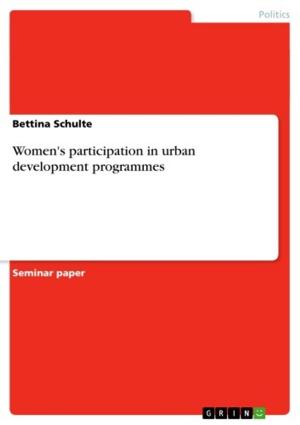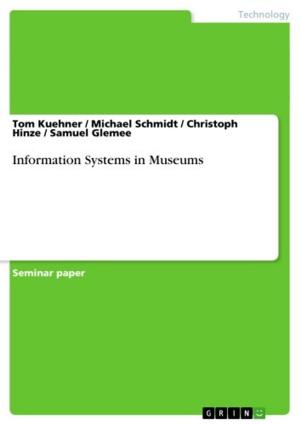The routinised use of ultrasound: Blessing or burden in women's pregnancy experiences?
Nonfiction, Social & Cultural Studies, Social Science, Sociology| Author: | Christine Schlapa | ISBN: | 9783638804042 |
| Publisher: | GRIN Publishing | Publication: | June 15, 2007 |
| Imprint: | GRIN Publishing | Language: | English |
| Author: | Christine Schlapa |
| ISBN: | 9783638804042 |
| Publisher: | GRIN Publishing |
| Publication: | June 15, 2007 |
| Imprint: | GRIN Publishing |
| Language: | English |
Essay from the year 2007 in the subject Sociology - Gender Studies, grade: 88%, University of Auckland (Department of Sociology), course: Family, Women and the State, 24 entries in the bibliography, language: English, abstract: Today, a number of medical technologies with varying degrees of accuracy are available for pregnant women. The most widely used prenatal diagnostic technology is ultrasound. Until the mid 1980s ultrasound was selectively offered to women with a high-risk pregnancy, but it is now considered a regular feature of prenatal care that can benefit all pregnant women. The psychological effects of ultrasound on the pregnancy experience have been widely explored and researchers found, that they are predominantly positive. However, little has yet been said about sociological aspects of the influence of ultrasound on women's pregnancy experiences. Therefore, this essay seeks to explore this topic in a sociological dimension, in order to answer the question, whether ultrasound is a benefit or a burden in regards to the pregnancy experiences of women. The essay sheds light on how ultrasound can be used for 'prenatal' family building as it allows the woman to involve her partner and members of the extended family in her pregnancy experience. The essay goes on to argue, that besides the empowerment of women's monopoly in family building strategies by ultrasound, the increased level of medicalisation of pregnancy has disempowering characteristics. After examining the influences of ultrasound at the women's status, it will be argued that also foetal images that have been influenced by ultrasound impact on women's pregnancy experiences. I will therefore discuss the 'prenatal paradox' of the construction of foetal personhood versus the image of the foetus as a consumer commodity. The last part of the essay shows how ultrasound influences the medical and societal view of having a disabled child in a time in which disability can be prevented by induced selective abortion.
Essay from the year 2007 in the subject Sociology - Gender Studies, grade: 88%, University of Auckland (Department of Sociology), course: Family, Women and the State, 24 entries in the bibliography, language: English, abstract: Today, a number of medical technologies with varying degrees of accuracy are available for pregnant women. The most widely used prenatal diagnostic technology is ultrasound. Until the mid 1980s ultrasound was selectively offered to women with a high-risk pregnancy, but it is now considered a regular feature of prenatal care that can benefit all pregnant women. The psychological effects of ultrasound on the pregnancy experience have been widely explored and researchers found, that they are predominantly positive. However, little has yet been said about sociological aspects of the influence of ultrasound on women's pregnancy experiences. Therefore, this essay seeks to explore this topic in a sociological dimension, in order to answer the question, whether ultrasound is a benefit or a burden in regards to the pregnancy experiences of women. The essay sheds light on how ultrasound can be used for 'prenatal' family building as it allows the woman to involve her partner and members of the extended family in her pregnancy experience. The essay goes on to argue, that besides the empowerment of women's monopoly in family building strategies by ultrasound, the increased level of medicalisation of pregnancy has disempowering characteristics. After examining the influences of ultrasound at the women's status, it will be argued that also foetal images that have been influenced by ultrasound impact on women's pregnancy experiences. I will therefore discuss the 'prenatal paradox' of the construction of foetal personhood versus the image of the foetus as a consumer commodity. The last part of the essay shows how ultrasound influences the medical and societal view of having a disabled child in a time in which disability can be prevented by induced selective abortion.















